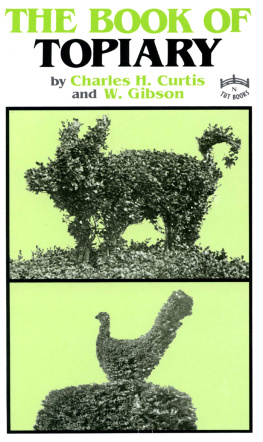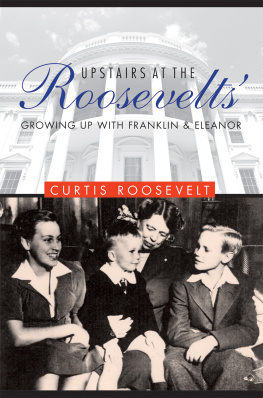Charles Curtis - Book of Topiary
Here you can read online Charles Curtis - Book of Topiary full text of the book (entire story) in english for free. Download pdf and epub, get meaning, cover and reviews about this ebook. publisher: Tuttle Publishing, genre: Romance novel. Description of the work, (preface) as well as reviews are available. Best literature library LitArk.com created for fans of good reading and offers a wide selection of genres:
Romance novel
Science fiction
Adventure
Detective
Science
History
Home and family
Prose
Art
Politics
Computer
Non-fiction
Religion
Business
Children
Humor
Choose a favorite category and find really read worthwhile books. Enjoy immersion in the world of imagination, feel the emotions of the characters or learn something new for yourself, make an fascinating discovery.
- Book:Book of Topiary
- Author:
- Publisher:Tuttle Publishing
- Genre:
- Rating:5 / 5
- Favourites:Add to favourites
- Your mark:
- 100
- 1
- 2
- 3
- 4
- 5
Book of Topiary: summary, description and annotation
We offer to read an annotation, description, summary or preface (depends on what the author of the book "Book of Topiary" wrote himself). If you haven't found the necessary information about the book — write in the comments, we will try to find it.
Book of Topiary — read online for free the complete book (whole text) full work
Below is the text of the book, divided by pages. System saving the place of the last page read, allows you to conveniently read the book "Book of Topiary" online for free, without having to search again every time where you left off. Put a bookmark, and you can go to the page where you finished reading at any time.
Font size:
Interval:
Bookmark:

TOPIARY
"If I do not defend the taste through thick and thin, I am prepared to admit that much may be said in its favour, and it is far from my intention to denounce it as either extravagant or foolish. It may be true, as I believe it is, that the natural form of a tree is the most beautiful possible for that particular tree, but it may happen that we do not always want the most beautiful form, but one of our own designing, and expressive of our ingenuity." Shirley Hibberd.
MODERN horticultural works, and especially those that are of the Dictionary type, do not as a rule take any notice whatever of Topiary, and those in which it is noticed deal with the subject with a brevity that is provoking, inasmuch as the student is little or none the wiser for the information given. "Johnson's Gardeners' Dictionary" is silent on the subject, and "Cassell's Popular Gardening" may be searched in vain for any reference to it.
Mr G. Nicholson, F.L.S., V.M.H., in his celebrated "Dictionary of Gardening," writes, under Topiary," Although the absurd fashion of cutting and torturing trees into all sorts of fantastic shapes has, happily, almost passed away, yet, as the art of the Topiarist was for a considerable period regarded as the perfection of gardening, some mention of it is desirable here. When the fashion first became general in Britain, it is probably impossible to ascertain; but it reached its highest point in the sixteenth century, and held its ground until driven out of the field in the last (eighteenth) century by the natural or picturesque style. From an archaeological point of view, it is not to be regretted that examples of Topiary work on a large scale still exist in several British gardens." Turning to the very recent "Cassell's Dictionary of Gardening" an all too concise account is found, but Mr W. P. Wright admits therein that Topiary "finds favour in many quarters to-day, although it only differs in degree and not in principle from the best examples of the Topiary art of the sixteenth century."

A PIG CUT IN BOX AT COMPTON WYNYATES
Encyclopaedias tell us very little of Topiary, and even that monumental work the "Encyclopaedia Britannica" contains within its portly tomes no reference to so historically interesting a subject, unless it be curiously hidden away. And even that very useful work "Chambers's Encyclopaedia" passes over Topiary as though such an art never existed.
To students of Etymology the word Topiary itself is of considerable interest. For the present work it must suffice to say that it is derived from the Latin topiarius, pertaining to ornamental gardening. One dictionary definition or meaning of the word is "shaped by cutting or clipping" and horticulturists will agree that this definition is both clever and descriptive, for Topiary work consists in giving all kinds of more or less fanciful forms to trees, hedges, and arbours.
An interesting reference is made in the "History of Oxfordshire" to the use of the phrase "Topiary Work." It is stated therein that "at Hampton Court, which was laid out about the middle of the reign of Henry VIII. by Cardinal Wolsey, there was a labyrinth, which still exists, covering only the quarter of an Acre of ground, yet its walks extending by their volutions over nearly half a mile. The walls also were covered with Rosemary. It was also long celebrated for its trees cut into grotesque forms, which Dr Plot admired and dignified with the name of Topiary Works."
THE MANAGEMENT AND TRAINING OF YOUNG TREES
IN my last chapter I dealt almost exclusively with the management of old trees. In this chapter I intend to devote the space principally to the treatment that will have to be followed in the training and shaping of young trees in the Topiary garden. I shall try to give as clear and concise an idea as possible to those who are contemplating laying out a garden, or who may already have done so, in which Topiary work is intended to be the main feature, although the training and shaping of young trees does not belong entirely to a garden in course of formation. Generally in old gardens, trees will be found in the course of being trained. If the garden has been laid out and the trees carefully planted on the lines advised in a previous chapter, a record should be carefully made as to the exact date when each tree was planted and also regarding the shape that each tree in the garden is intended to represent when it is finished. A record of that description, made at the period of the work, will prove of great interest in after years, both to those who own the garden and to others who are either interested in it or may happen to visit it. A record of the date of planting and the shapes that the trees were originally meant to represent, seems to have been a thing quite neglected during the formation of the old Topiary gardens, which seems to me to be a very great pity.
To a great extent the general management of young trees is altogether different from the management required to be given to old trees; inasmuch as the difficulties are more numerous, and the care and attention necessary to be bestowed on them more manifold. Our forefathers with the greatest skill and care laid out and formed the old established Topiary gardens of the present day, and afterwards year by year trained and shaped the fine old specimens of the Topiary art now to be seen in some of the old gardens, so that when a person is walking through one of these gardens, and examining the quaint and curious shapes of the trees, he cannot fail to admire them and to reflect upon the amount of skill and labour that has been bestowed on them. It would be curious, indeed, if he failed to pause, and consider the amount of patience the gardeners of earlier years were endowed with. In many respects the gardener of the present time has the advantage in Topiary work at least over his brother of one or two hundred years ago. Whether the gardeners of the present day are more skilled in that special art, is a question which I am not prepared to answer; but I am certain that there is no mistaking the abilities of the old gardeners in the art of training trees. The work they have left behind them proves this beyond a doubt. The gardener of the present day has more variety of shapes to choose from, and a larger and more varied selection of trees to work upon.
If the trees were a good size and well grown when they were planted, the work of clipping and training them may be commenced the following year, according to the shape into which it is intended to form the tree. It is not advisable that any clipping or training be done to the trees the same autumn or winter that they are planted. It should be deferred until the following autumn, in order to allow of fresh root action taking place. Some of the trees can be clipped into certain shapes when they are quite small; but for other shapes a much larger tree is necessary to commence work upon. It is a very wise policy to go to a little extra expense on the original outlay of the trees, rather than buy small trees that will be of no use whatever for the work for which they are ultimately intended.
If the suggestion that I made in a previous chapter has been acted upon, viz., the buying in of the required number of trees some years before the work of making the garden is taken in hand, and bringing them on in the home nursery beds until they have become a suitable size, and until the time arrives when they are required for planting in their permanent places in the garden, the actual cost of the trees will be reduced to a minimum, and better and more suitable trees secured than if they had been purchased direct from some of the nurserymen.
Font size:
Interval:
Bookmark:
Similar books «Book of Topiary»
Look at similar books to Book of Topiary. We have selected literature similar in name and meaning in the hope of providing readers with more options to find new, interesting, not yet read works.
Discussion, reviews of the book Book of Topiary and just readers' own opinions. Leave your comments, write what you think about the work, its meaning or the main characters. Specify what exactly you liked and what you didn't like, and why you think so.













